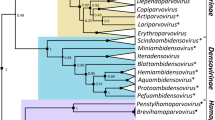Abstract
A contemporary and fundamental problem faced by many evolutionary biologists is how to puzzle together a collection ℘ of partial trees (leaf-labeled trees whose leaves are bijectively labeled by species or, more generally, taxa, each supported by, e.g., a gene) into an overall parental structure that displays all trees in ℘. This already difficult problem is complicated by the fact that the trees in ℘ regularly support conflicting phylogenetic relationships and are not on the same but only overlapping taxa sets. A desirable requirement on the sought after parental structure, therefore, is that it can accommodate the observed conflicts. Phylogenetic networks are a popular tool capable of doing precisely this. However, not much is known about how to construct such networks from partial trees, a notable exception being the Z-closure super-network approach, which is based on the Z-closure rule, and the Q-imputation approach. Although attractive approaches, they both suffer from the fact that the generated networks tend to be multidimensional making it necessary to apply some kind of filter to reduce their complexity.
To avoid having to resort to a filter, we follow a different line of attack in this paper and develop closure rules for generating circular phylogenetic networks which have the attractive property that they can be represented in the plane. In particular, we introduce the novel Y-(closure) rule and show that this rule on its own or in combination with one of Meacham’s closure rules (which we call the M-rule) has some very desirable theoretical properties. In addition, we present a case study based on Rivera et al. “ring of life” to explore the reconstructive power of the M- and Y-rule and also reanalyze an Arabidopsis thaliana data set.
Similar content being viewed by others
References
Bandelt, H., Dress, A., 1992. A canonical decomposition theory for metrics on a finite set. Adv. Math. 92, 47–05.
Bininda-Emonds, O., 2004. Phylogenetic Supertrees: Combining Information to Reveal the Tree of Life. Computational Biology Series, vol. 4. Kluwer Academy, Dordrecht.
Bryant, D., Moulton, V., 2004. Neighbor-Net: an agglomerative method for the construction of phylogenetic networks. Mol. Biol. Evol. 21(2), 255–65.
Dress, A., Huson, D.H., 2004. Constructing splits graphs. IEEE/ACM Trans. Comput. Biol. Bioinform. 1, 109–15.
Fitzpatrick, D., Creevey, C., McInerney, J., 2006. Genome phylogenies indicate a meaningful alpha-proteobacterial phylogeny and support a grouping of the mitochondria with the Rickettsiales. Mol. Biol. Evol. 23, 74–5.
Grünewald, S., Forslund, K., Dress, A., Moulton, V., 2007. QNet: an agglomerative method for the construction of phylogenetic networks from weighted quartets. Mol. Biol. Evol. 24(2), 532–38.
Gusfield, D., Edduh, S., 2004. The fine structure of galls in phylogenetic networks. INFORMS J. Comput. 16(4), 459–69.
Hamed, B.M., 2005. Neighbour-nets portray the Chinese dialect continuum and the linguistic legacy of China’s demic history. Proc. R. Soc. B 272(1567), 1471–954.
Holland, B., Conner, G., Huber, K.T., Moulton, V., 2007. Imputing supertrees and supernetworks from quartets. Syst. Biol. 56(1), 57–7.
Huber, K.T., Moulton, V., 2005. Phylogenetic networks. In: Gascuel, O. (Ed.), Mathematics of Evolution and Phylogeny. Oxford University Press, London
Huber, K.T., Moulton, V., 2006. Phylogenetic networks from multi-labelled trees. J. Math. Biol. 52, 613–32.
Huson, D.H., Bryant, D., 2005. Application of phylogenetic networks in evolutionary studies. Mol. Biol. Evol. 23(4), 254–67.
Huson, D.H., Dezulian, T., Kloepper, T.K., Steel, M.A., 2004. Phylogenetic super-networks from partial trees. IEEE Trans. Comput. Biol. Bioinform. 1, 151–58.
Huson, D.H., Kloepper, T.H., Lockhart, P.J., Steel, M.A., 2005. Reconstruction of reticulate networks from gene trees, LNBI 3500, pp. 233–49.
Martin, W., Embley, T.M., 2004. Early evolution comes full circle. Nature 431, 134–37.
McBreen, K., Lockhart, P.J., 2006. Reconstructing reticulate evolutionary histories in plants. Trends Plant Sci. 11(8), 389–04.
Meacham, C.A., 1983. The recovery of trees from measures of dissimilarity. In: Hodson, F.R., Kendall, D.G., Tatu, P. (Eds.), Mathematics in the Archaeological and Historical Sciences, pp. 387–95. Edinburgh University Press, Edinburgh.
Morrison, D., 2005. Networks in phylogenetic analysis: new tools for population biology. Int. J. Parasitol. 35, 567–82.
Rivera, M.C., Lake, J.A., 2004. The ring of life provides evidence for a genome fusion origin of eukaryotes. Nature 43, 152–55.
Semple, C., Steel, M., 2001. Tree Reconstruction Via Closure Operations on Partial Splits, JOBIM 2000, LNCS, vol. 2066, pp. 126–34. Springer, Berlin.
Semple, C., Steel, M., 2003. Phylogenetics. Oxford University Press, London.
Simonson, A.B., Servin, J.A., Skophammer, R.G., Herbold, C.W., Rivera, M.C., Lake, J.A., 2005. Decoding the genomic tree of life. PNAS 102(Suppl. 1), 6608–613.
Author information
Authors and Affiliations
Corresponding author
Rights and permissions
About this article
Cite this article
Grünewald, S., Huber, K.T. & Wu, Q. Two Novel Closure Rules for Constructing Phylogenetic Super-Networks. Bull. Math. Biol. 70, 1906–1924 (2008). https://doi.org/10.1007/s11538-008-9331-4
Received:
Accepted:
Published:
Issue Date:
DOI: https://doi.org/10.1007/s11538-008-9331-4




